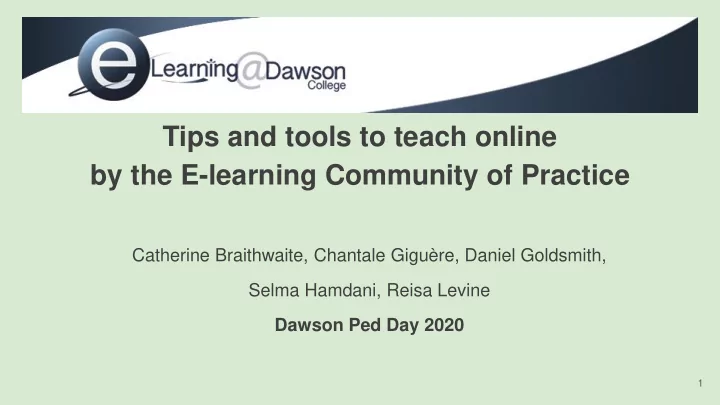

Tips and tools to teach online by the E-learning Community of Practice Catherine Braithwaite, Chantale Giguère, Daniel Goldsmith, Selma Hamdani, Reisa Levine Dawson Ped Day 2020 1
E-learning Community of Practice GOALS ● Reflect on online pedagogy with colleagues from other departments ● Explore useful online tools and software ● Develop a blended course in your department/ program ● Implement it with 1 of your groups ● Share your experience with the Dawson Community 2
Terminology Synchronous lesson = offered in real Online = Use of course websites, time at the time of the course (ex: platforms, devices to deliver content and interactive tools by web conference) communicate Asynchronous lesson = learning Blended / hybrid / partly online = activities with flexible schedule within the Courses that combine face-to-face prescribed deadlines (Ex: access activities with online activities interactive online content, submit assignments online, forum, etc.)
Tony Bates " In terms of making decisions about mode of delivery , we should be asking, not which is the best method overall, but : What are the most appropriate conditions for using face-to-face, blended or fully online learning respectively? " Teaching in a Digital Age - Guidelines for designing teaching and learning, Chapter 9.2, p. 316. Openbook Free download: https://opentextbc.ca/teachinginadigitalage/
Today’s Student ● Students generally comfortable in online environments. ○ However, their strengths on social media does NOT necessarily flow into educational technology use. ● Diversity in the classroom = diverse learning styles. ● For many students, Half of Cdn post-secondary students technology = autonomy also have jobs (work an average of 16hrs/week)
Skills for the Knowledge-Society • Communications skills • Ability to learn independently • Ethics and responsibility • Teamwork and flexibility • Digital skills • Thinking skills (critical thinking, problem -solving, creativity, originality, strategizing) The key skill in a knowledge-based society is knowledge management : how to find, evaluate, analyze, apply and disseminate information, within a particular context. (adapted from Conference Board of Canada, 2014)
Advantages for students ● Flexibility of time & location ● Accommodates for different learning styles
Advantages for students ● less intimidating for group or individual presentations ● Less intimidating to ask questions
Advantages for Students More time for higher level learning when asynchronous (esp. when combined with “flipped” approach) Students can revisit content and lessons more easily (review for tests and assignments)
Advantages for Students Students can learn at their own rhythm (especially in asynchronous lessons) Autonomy and independence can increase motivation
Advantages for Students Regular and fast feedback (more for synchronous)
Advantages for teachers ● Tailoring pace of class and content to the student’s feedback ● Identify more quickly the misunderstandings of concepts ● Get to know the students more deeply
Challenges for teachers Time management, including determining the appropriate duration of each element of the course, Possible loss of student participation
Challenges for teachers Need to be able to quickly adjust to student feedback; tailor responses to students; Frequently check the “pulse of the class” Big time investment to develop new material
Challenges for teachers Possible contentious interactions with colleagues and administration (dealing with misperception, questions of ponderation/contact hours with students etc.)
Challenges for teachers •Efficiently using learning platform and course development software •Planning the pedagogical sequence •Choosing the right medium for each activity (online or face-to-face) •Supporting students in the learning process (strong and week)
Challenges for students Time management Staying focused on task Autonomy in learning
Recommendations ● Set the class community spirit early ● Explain roles and expectations (remind throughout the semester) ● Offer a range of learning options (text based, audio/video, links to additional content) ● Be aware of class dynamics! Know your students - both online and IRL (In Real Life) Communication is key! ● Make good technology choices and get appropriate technological support ● Choose the appropriate course to teach online and choose the appropriate online course modality according to discipline, competencies, etc. ● Develop your blended course step by step ● Consider inclusion and accessibility during the course development process (not after) to limit the accommodations ● Develop an active, engaging and student centered online course
Please join a Fellow for part 2 : exploration of a tool or example of online course/ activity 10 min. / table
Recommend
More recommend